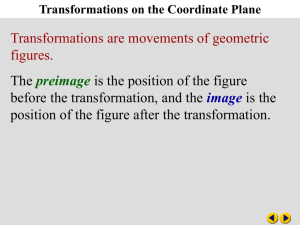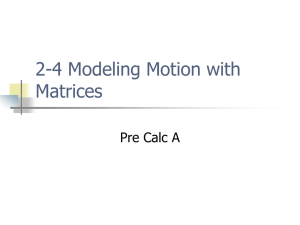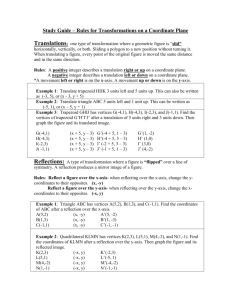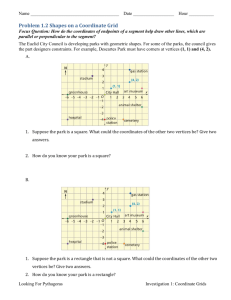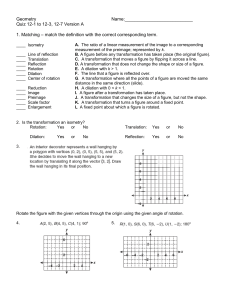Transformations on the Coordinate Plane Presentation
advertisement
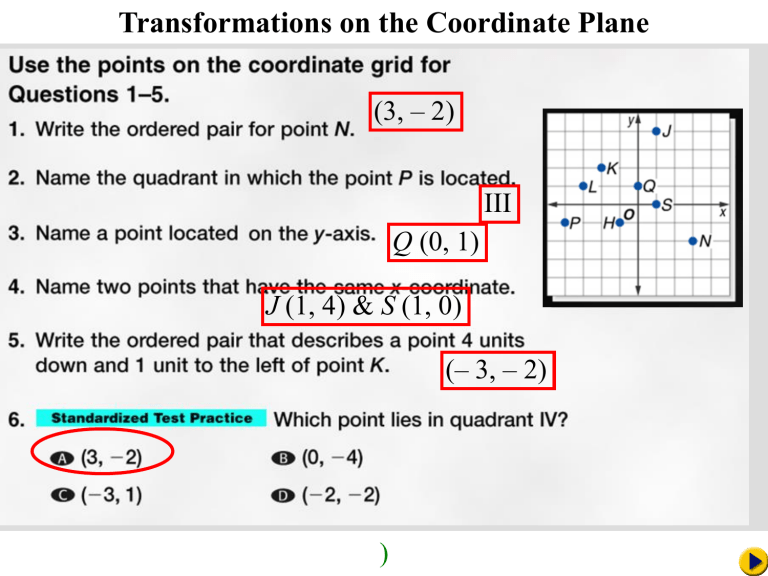
Transformations on the Coordinate Plane (3, – 2) III Q (0, 1) J (1, 4) & S (1, 0) (– 3, – 2) ) Transformations on the Coordinate Plane Transformations are movements of geometric figures. The preimage is the position of the figure before the transformation, and the image is the position of the figure after the transformation. Transformations on the Coordinate Plane Transformations on the Coordinate Plane Reflection: a figure is flipped over a line Translation: a figure is slid in any direction Dilation: a figure is enlarged or reduced Rotation: a figure is turned around a point Identify Transformations Identify the transformation as a reflection, translation, dilation, or rotation. Answer: The figure has been increased in size. This is a dilation. Identify Transformations Identify the transformation as a reflection, translation, dilation, or rotation. Answer: The figure has been shifted horizontally to the right. This is a translation. Identify Transformations Identify the transformation as a reflection, translation, dilation, or rotation. Answer: The figure has been turned around a point. This is a rotation. Identify Transformations Identify the transformation as a reflection, translation, dilation, or rotation. Answer: The figure has been flipped over a line. This is a reflection. Identify Transformations Identify each transformation as a reflection, translation, dilation, or rotation. a. b. Answer: rotation Answer: reflection d. c. Answer: dilation Answer: translation Transformations on the Coordinate Plane Reflection A trapezoid has vertices W(–1, 4), X(4, 4), Y(4, 1) and Z(–3, 1). Trapezoid WXYZ is reflected over the y-axis. Find the coordinates of the vertices of the image. To reflect the figure over the y-axis, multiply each x-coordinate by –1. (x, y) W(–1, 4) X(4, 4) Y(4, 1) Z(–3, 1) (–x, y) (1, 4) (–4, 4) (–4, 1) (3, 1) Answer: The coordinates of the vertices of the image are W(1, 4), X(–4, 4), Y(–4, 1), and Z(3, 1). Reflection A trapezoid has vertices W(–1, 4), X(4, 4), Y(4, 1), and Z(–3, 1). Graph trapezoid WXYZ and its image W X Y Z. Answer: Graph each vertex of the trapezoid WXYZ. Connect the points. X Graph each vertex of the reflected image W X Y Z. Connect the points. Y W Z W X Z Y Reflection A parallelogram has vertices A(–4, 7), B(2, 7), C(0, 4) and D(–2, 4). a. Parallelogram ABCD is reflected over the x-axis. Find the coordinates of the vertices of the image. Answer: A(–4, –7), B(2, –7), C(0, –4), D(–2, –4) Reflection b. Graph parallelogram ABCD and its image A B C D. Answer: Transformations on the Coordinate Plane Translation Triangle ABC has vertices A(–2, 1), B(2, 4), and C(1, 1). Find the coordinates of the vertices of the image if it is translated 3 units to the right and 5 units down. To translate the triangle 3 units to the right, add 3 to the x-coordinate of each vertex. To translate the triangle 5 units down, add –5 to the y-coordinate of each vertex. Answer: The coordinates of the vertices of the image are A(1, –4), B(5, –1), and C(4, –4). Translation Graph triangle ABC and its image. Answer: B The preimage is The translated image is . A C A B C Translation Triangle JKL has vertices J(2, –3), K(4, 0), and L(6, –3). a. Find the coordinates of the vertices of the image if it is translated 5 units to the left and 2 units up. Answer: J(–3, –1), K(–1, 2), L(1, –1) b. Graph triangle JKL and its image. Answer: Transformations on the Coordinate Plane Dilation A trapezoid has vertices E(–1, 2), F(2, 1), G(2, –1), and H(–1, –2). Find the coordinates of the dilated trapezoid E F G H if the scale factor is 2. To dilate the figure, multiply the coordinates of each vertex by 2. Answer: The coordinates of the vertices of the image are E(–2, 4), F(4, 2), G(4, –2), and H(–2, –4). Dilation Graph the preimage and its image. Answer: E The preimage is trapezoid EFGH. F The image is trapezoid E F G H . Notice that the image has sides that are twice the length of the sides of the original figure. F E G H H G Dilation A trapezoid has vertices E(–4, 7), F(2, 7), G(0, 4), and H(–2, 4). a. Find the coordinates of the dilated trapezoid E F G H if the scale factor is Answer: Dilation b. Graph the preimage and its image. Answer: Transformations on the Coordinate Plane Rotation Triangle ABC has vertices A(1, –3), B(3, 1), and C(5, –2). Find the coordinates of the image of ABC after it is rotated 180° about the origin. To find the coordinates of the image of ABC after a 180° rotation, multiply both coordinates of each point by –1. Answer: The coordinates of the vertices of the image are A(–1, 3), B(–3, –1), and C(–5, 2). Rotation Graph the preimage and its image. Answer: The preimage is The translated image is . A C B B C A Rotation Triangle RST has vertices R(4, 0), S(2, –3), and T(6, –3). a. Find the coordinates of the image of RST after it is rotated 90° counterclockwise about the origin. Answer: R(0, 4), S(3, 2), T(3, 6) b. Graph the preimage and the image. Answer:

